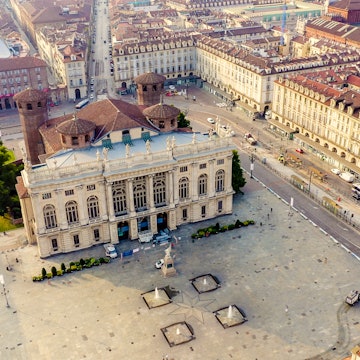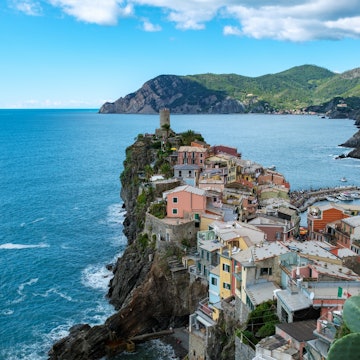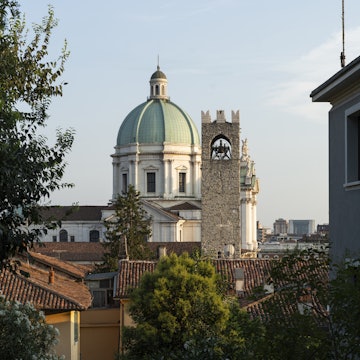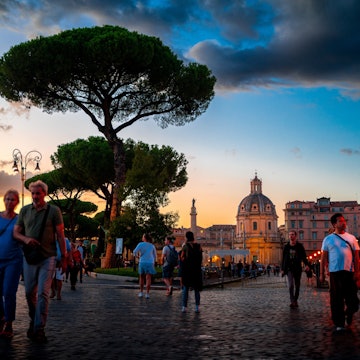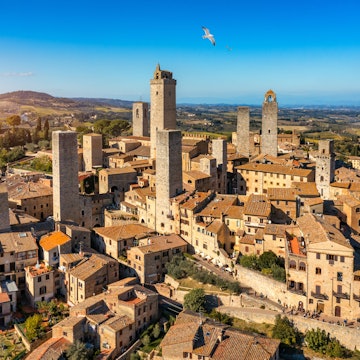

The Dolomites offer adventures outside the ordinary. Artur Debat/Getty Images
Mountain paradise might not be the first superlative that comes to mind when you think of Italy, but if you know where to look, you'll find Alpine scenery to rival anywhere in Switzerland, Austria or France.
While tourists flock to over-touristed destinations such as Venice, Florence, the Cinque Terre and the Amalfi Coast, the Dolomites – the breathtaking mountains traversing the autonomous provinces of Trentino and Alto Adige and parts of Veneto – remain under the radar, perfectly content with their status as the country’s most spectacular underdog.
Part of the Austro-Hungarian empire until 1918, and annexed by Italy just a year later, this rugged region remains distinct from the Italian mainstream in myriad ways. Take the language – some 70% of Trentino-Alto Adige residents speak German, vastly outnumbering speakers of Italian and Ladin, the region’s other two official languages.
Then there's the cuisine – a hearty and wholly delectable fusion of Italy and the Alps – and the architecture, blending Austrian baroque and a pinch of traditional Südtiroler farmhouse. And as for the culture? Well, you’re not in Napoli, anymore, Dorothea! Taken together, this makes for a fascinating cultural collision.
Coupled with incredible winter sports and summer outdoor adventures, the Dolomites stand tall as one of the most intriguing – and drop-dead gorgeous – spots on earth. Here's what you need to know on your first trip.

When should I go to the Dolomites?
The Dolomites offer incredible experiences in summer and winter, but outside of the major cities, the region is not well set up for year-round tourism. After the winter ski season ends in February, many hotels close until May, alongside other tourist-dependent infrastructure, so spring is best avoided.
In summer, outdoor adventures rule in the region’s pristine national parks, with hiking, climbing, cycling and mountain biking hogging the spotlight through until September. Then there’s a second period of closures in October and November, before the winter ski season ramps up in December.
Winter is a great time to visit. You can whoosh down some of Europe’s most compelling skiing and snowboarding slopes at 31 ski resorts, and enjoy atmospheric Christmas markets during the holidays in Bolzano, Merano and other hubs.
How much time should I spend in the Dolomites?
The Dolomites cover nearly 1500 sq km of northeastern Italy, and getting around can take time. The first question to ask yourself is whether you want to hone in one place (such as a particular ski resort or city) or move around, exploring as much of the region as possible. Either way, give yourself at least a week in the mountains.
When visiting cities such as Bolzano, Merano, Bressanone and Trento, you can take in the highlights in a day or two, but exploring the beautiful valleys, ski resorts and national parks requires more time. One worthwhile approach is to focus on a single valley, such as Val Badia, Val Gardena or Val di Fassa, exploring from bottom to top.
Serious hikers and climbers will want to devote several days to the region’s standout national parks, such as Parco Naturale Sciliar-Catinaccio and Parco Nazionale Dello Stelvio. Those wanting to take in all the region's highlights should set aside at least two weeks for the adventure.

Is it easy to get around in the Dolomites?
Bolzano and Trento are the main points of entry to the Dolomites, and both are on Italy’s high-speed railway network. The trip from Rome to Bolzano takes just over five hours. However, while both Trentino and Alto Adige have excellent public bus systems, services don't reach every corner.
A car is necessary if you hope to explore the region’s myriad valleys in a time-efficient manner. There are incredible nooks and crannies everywhere, and having control of your own transport schedule is invaluable if you want to get under the skin of the Dolomites.
When it comes to local exploring, all of Trentino-Alto Adige’s cities have walkable historic centers, and many mountaintop resorts can be reached via funiculars and ski lifts from the valley floor.

Top things to do in the Dolomites
In winter and summer, the Dolomites are mostly about outdoor adventures. Even if you are heading indoors to a museum or a restaurant, you’ll likely have to pass through spectacular scenery to get there, so keep your camera at the ready.
Ski the Sella Ronda, one of Europe’s most iconic ski routes
The Dolomites are a world-class skiing and snowboarding destination, and there’s no better snow-based adventure than the famed Sella Ronda – a 40km circuit around the Gruppo di Sella mountain range. Climbing to 3151m at Piz Boé, the slopes are linked by various cable cars and chairlifts strung across four mountains and the valleys of Val Gardena, Val Badia, Arabba and Val di Fassa.
The Sella Ronda slopes are covered by the Dolomiti Superski – a ski pass valid for 12 of the Dolomites’ most epic ski resorts, connecting 1200km of ski runs via 450 lifts. Taking in the Plan de Corones (Kronplatz), Alta Badia, Cortina d'Ampezzo, Val di Fassa, Val di Femme and Val Gardena/Alpe di Siusi (Seiser Alm), among other ski areas, it’s a winter powder pilgrimage that's hard to beat.
Take a deep dive to the cuisine of Ladinia around Val Badia
The cuisine of Italy’s Ladin people – a minority ethnolinguistic group making up 4.5% of the population in South Tyrol – forms a vital part of the gastronomic journey in the Dolomites. Specialties to track down include cajincì (similar to ravioli), bales da ciociul (smoked ham dumplings) and puncerli da pavè (poppy seed pastries).
Ladin culture thrives in the Val di Fassa in Trentino, Val Gardena and Val Badia in South Tyrol, and Cortina d'Ampezzo and Fodom in Veneto – a region collectively known as Ladinia. Some of the best restaurants for Ladin cuisine can be found in and around Corvara, the heart of Val Badia; favorites include Restaurante Ladinia, Prè de Costa and La Stüa De Michil. Bun apetit!

Discover some of Italy’s best wines around Trento and the Südtiroler Weinstrasse
It may come as a surprise that anything other than lagers, helles, dunkels and bocks would flourish in such a Germanic-leaning region, but Trentino-Aldo Adige produces some extraordinary wines. One particularly worthwhile wine region to explore is Trento DOC, the first Italian appellation reserved exclusively for sparkling wines made using bottle fermentation – the méthode traditionnelle made famous by France's Champagne region. There are 67 Trento DOC wineries dotting the hillsides outside Trento, producing the region's prized bubbly (available in white and rosé varieties) using only Trentino grapes.
Around Bolzano, bold red wines such as Lagrein, lighter Santa Maddalena and Vernatsch, and lovely whites such as Gewürztraminer flourish. The Südtiroler Weinstrasse region begins northwest of Bolzano in Nals and meanders through Upper Adige and Lower Adige, where the landscape is filled with rolling vineyards fringed by apple orchards.
Swig a beer at the highest microbrewery in Europe
Few beers go down as gratifyingly as those from Hungarian beer brewer Gábor Sogorka, which produces five Reinheitsgebot-adherent beers at Rifugio Lavarella, Europe's highest microbrewery, in the Parco Naturale Fanes-Sennes-Braies north of Cortina d'Ampezzo.
It’s an exhilarating, two-hour hike from the trailhead near the Pederü Berggasthaus in San Vigilio di Marebbe to reach the refuge, where your efforts will be rewarded with your choice of tipple at 2050m. Take your pick from a blonde beer, a Weizenbier, a mountain pilsner, an amber ale or an IPA. Brews, accompanied by outstanding views in all directions, flow from mid-June to mid-October and late-January to mid-April.

Explore some of the world’s most fascinating – and precariously-placed – mountain museums
Being the first climber to ascend Mount Everest without supplemental oxygen (in 1978) was not enough for South Tyrolean mountaineering legend Reinhold Messner – the great alpinist also founded six unorthodox but architecturally daring museums peppered around the Dolomites.
The flagship of the project, Messner Mountain Museum (MMM) Firmiano, is easily accessible inside the Sigmundskron Castle near Bolzano, but the sky-high museums of MMM Corones and MMM Dolomites are perched atop mountains in precarious, hard-to-reach positions.
The collections, exploring humankind's complex relationship with the mountains across all cultures, are fascinating but secondary to the design and GPS coordinates. A combined MMM Tour-Ticket (adult/child €55/25) is valid for one year, providing access to all six museums.
My favorite thing to do in the Dolomites
Living in Bologna, I can reach Bolzano in just 2.5 hours on the high-speed train. For me, one of the greatest joys is being able to travel somewhere that, while technically in the same country, is different enough from my everyday norm that it feels strange not having to show my passport to enter!
On arrival, I make a beeline for the food! The cuisine of the Dolomites is a fascinating trifecta of all the things Italy does well, fused with the hearty Alpine/Tirolean traditions of Austria and the unique, hyper-regional gastronomy of Ladinia. One of the Dolomites' great joys is chasing a hearty venison ragú or Tirolean goulash with a big, bold red wine from the region (Lagrein is my go-to).
Ideally, this would be enjoyed while admiring jaw-dropping views of the Dolomites from a cozy, fireplace-warmed stube – a traditional wood-paneled dining room. The Dolomites are impossibly gorgeous – with jagged peaks jutting into the sky in all directions – and as I’m no skier, I'll take a beer and a view any day!
How much money do I need for the Dolomites?
Trentino-Alto Adige is an expensive destination by Italian standards. Accommodation costs in particular are noticeably higher than in other parts of Italy, both in cities such as Bolzano and Merano and in mountain chalets and ski resorts, though quality is almost always high. To stay in decent accommodations, dine in midrange restaurants and enjoy a daily activity or two, you'll need a budget of at least €250 per day. If you’re a skier, those costs will rise.
Here's an overview of standard travel costs in the region.
Double room: €175–300 (US$190–324)
Dolomiti Superski Pass per day: adult/child €75/38 (US$81/41)
Public transport ticket: Often free when you book accommodations
Cup of coffee: €1.50–2 (US$1.60–2.15)
Dinner for two in a traditional stube: €60–100 (US$65–108)
Beer/pint at a brewery: €5.50 (US$6)









